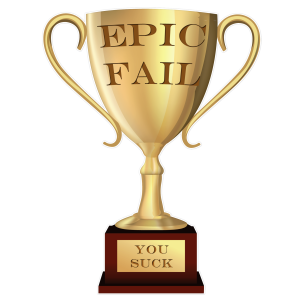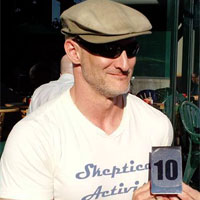By Jay Diamond
I know, I know… the title of this blog sounds like an Orwellian plot device or the usual self-help platitudes that drives skeptics insane. Hold tight while I explain…
 There’s a growing body of evidence in psychology, management science, and other disciplines around the value of failure. Learning from failures is often more powerful than learning from success in conditioning managers to win in the marketplace or catching prey on the savanna.
There’s a growing body of evidence in psychology, management science, and other disciplines around the value of failure. Learning from failures is often more powerful than learning from success in conditioning managers to win in the marketplace or catching prey on the savanna.
Anecdotally, I’ve learned more about business from bad managers than good ones, never quite knowing what went right when we succeed, but having a much better idea what NOT to do the next time under failure. Coworkers who didn’t understand how to assimilate the lessons of failure seemed doomed to repeat them. Coworkers who had an early string of successes were perplexed and faltered when things went wrong. It seems that accepting and learning from failure are a key to long-term success. In Silicon Valley, where I live, entrepreneurs wear failures as badges of honor – a sign that they have the experience necessary to succeed over the long haul.
To understand the limits of a motorcycle, you need to drive that machine to the limit, and crossing that limit results in hospital time or death. To understand the limits of a relationship, you need to push it to frustrating and intolerable levels– and exceeding those levels result in inevitable breakup and possibly a murder-suicide crime scene. In bodybuilding, the value of failure is much more obvious and much less risky than the rest of life.
I use a simple ladder of progression for weight-bearing exercises at the gym. I start with three sets (groupings with a short break in between) of 10 reps (repetitions of the same exercise in quick succession) with very little or no weight. Once I have perfect form, I start increasing the weight until I’m struggling to do three sets. And then I increase a little more, and I fail.
Failure means that I exceed the capacity of my muscles. I cannot complete one more press with good form. I might go half-way but I can go no more. It’s my absolute, unquestionable limit.
And the something funny happens… after a few failed attempts on successive days, I succeed. Then I bump up the weight and fail. Until I succeed. Rinse, repeat.
And that, ladies and gentlemen,
is the secret to bodybuilding.
With nothing more to add, I’ll continue to ramble incoherently for pure entertainment value.
How much weigh do you start with? Zero.
Get the form right, feel comfortable with the motion, then add weight – and the amount depends on you. You’re competing against yourself… or rather yourself from your last workout.
A friend recently told me that his workouts had become much more difficult after resuming the practice. He could run farther, push more weight, and generally exerted much less effort in previous years. He attributed it to age. I attribute it to doing it wrong.
If a workout is easy, you aren’t building muscle – you aren’t even maintaining because the body adapts to the stress to handle it with less effort. Building fitness is a process of forcing your body to adapt to stress. Once adapted, there is little stress and therefore little adaptation. When you complete a workout you should feel tired and have sore muscles for a day or two. That’s the feeling of improvement.
In the first of these VitaminJ blog entries (“The Moment That Changes Everything”), I talk about the “civilians” – the ~85% of gym attendees who are mistakenly convinced that they are working out when in fact that are justifying their gym membership by attendance. It’s better to do something than nothing, but this blog is about methodical self-improvement over an extended duration. If you simply want to walk around the block, do that.
Just know that you can do better. Much better.
So what are you waiting for? Get out there and FAIL!
______________________________________________________________________________________________________
 Jay Diamond writes the VitaminJ blog on evidence-based fitness & bodybuilding. Jay is the founder of Reason4Reason – a skeptical activist group based in the San Francisco bay area. He holds dual masters degrees in engineering and business and has managed both startup companies and hundred-million-dollar programs for Fortune 50 companies. Growing up in Canada, he performed magic, studied science, and became aware of the skeptical movement. Jay has lectured around the world on science & technology, business, and skepticism.
Jay Diamond writes the VitaminJ blog on evidence-based fitness & bodybuilding. Jay is the founder of Reason4Reason – a skeptical activist group based in the San Francisco bay area. He holds dual masters degrees in engineering and business and has managed both startup companies and hundred-million-dollar programs for Fortune 50 companies. Growing up in Canada, he performed magic, studied science, and became aware of the skeptical movement. Jay has lectured around the world on science & technology, business, and skepticism.
